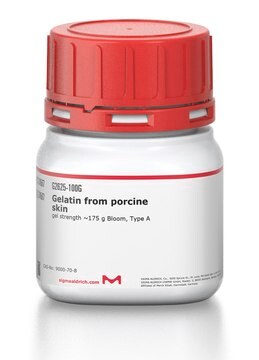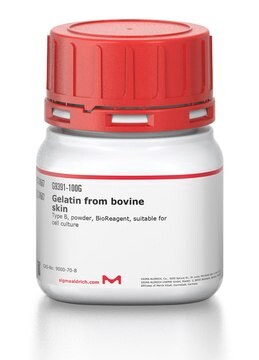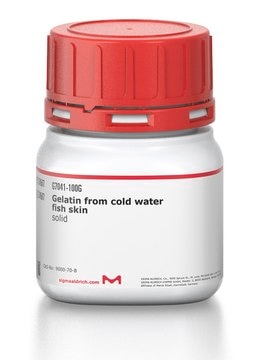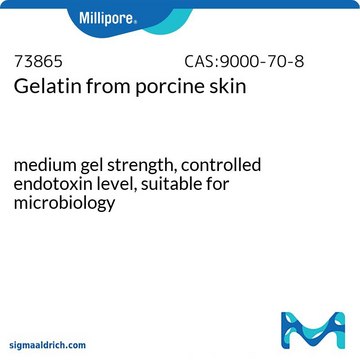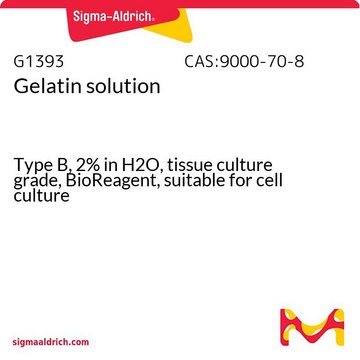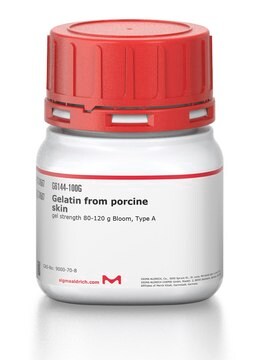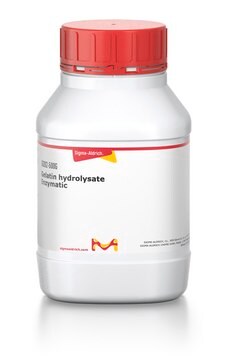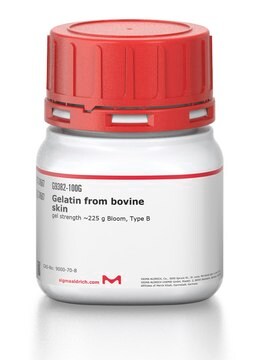48722
Gelatina
medium gel strength, suitable for microbiology
Sinonimo/i:
Gelatine, hydrolyzed collagen, collagen hydrolysate, gelatine hydrolysate
About This Item
Prodotti consigliati
Origine biologica
Porcine
Livello qualitativo
Sterilità
non-sterile
Forma fisica
powder
Qualità
medium gel strength
Confezionamento
bottle of 100 g
bottle of 500 g
Residuo alla calcinazione
≤2%
Perdita
≤15% loss on drying
Colore
light yellow
pH
4.0-6.0 (25 °C, 67 mg/mL in H2O)
Resistenza del gel
165-195 g Bloom (67 mg/ml water)
Solubilità
H2O: 67 mg/mL at 50 °C, slightly hazy, slightly yellow
Anioni in tracce
chloride (Cl-): ≤3000 mg/kg
Cationi in tracce
Ca: ≤2000 mg/kg
Cd: ≤5 mg/kg
Co: ≤5 mg/kg
Cr: ≤10 mg/kg
Cu: ≤50 mg/kg
Fe: ≤50 mg/kg
K: ≤500 mg/kg
Mg: ≤500 mg/kg
Mn: ≤5 mg/kg
Na: ≤5000 mg/kg
Ni: ≤5 mg/kg
Pb: ≤5 mg/kg
Zn: ≤10 mg/kg
applicazioni
microbiology
Cerchi prodotti simili? Visita Guida al confronto tra prodotti
Descrizione generale
Gelatin is a heterogeneous mixture of water-soluble proteins of high average molecular masses present in collagen. Proteins are extracted by boiling the relevant skin, tendons, ligaments, bones, etc., in water. Type A gelatin is derived from acid-cured tissue, and Type B from lime-cured tissue.
The Bloom number, determined by the Bloom gelometer, is an indication of the strength of a gel formed from a solution of the known concentration. The Bloom number is proportional to the average molecular mass. Bloom numbers of porcine skin Gelatin vary from 90 to 300 g. This product has a gel strength of 180.
Applicazioni
Componenti
Avvertenza
Nota sulla preparazione
Codice della classe di stoccaggio
11 - Combustible Solids
Classe di pericolosità dell'acqua (WGK)
nwg
Dispositivi di protezione individuale
Eyeshields, Gloves, type N95 (US)
Scegli una delle versioni più recenti:
Possiedi già questo prodotto?
I documenti relativi ai prodotti acquistati recentemente sono disponibili nell’Archivio dei documenti.
I clienti hanno visto anche
Il team dei nostri ricercatori vanta grande esperienza in tutte le aree della ricerca quali Life Science, scienza dei materiali, sintesi chimica, cromatografia, discipline analitiche, ecc..
Contatta l'Assistenza Tecnica.

